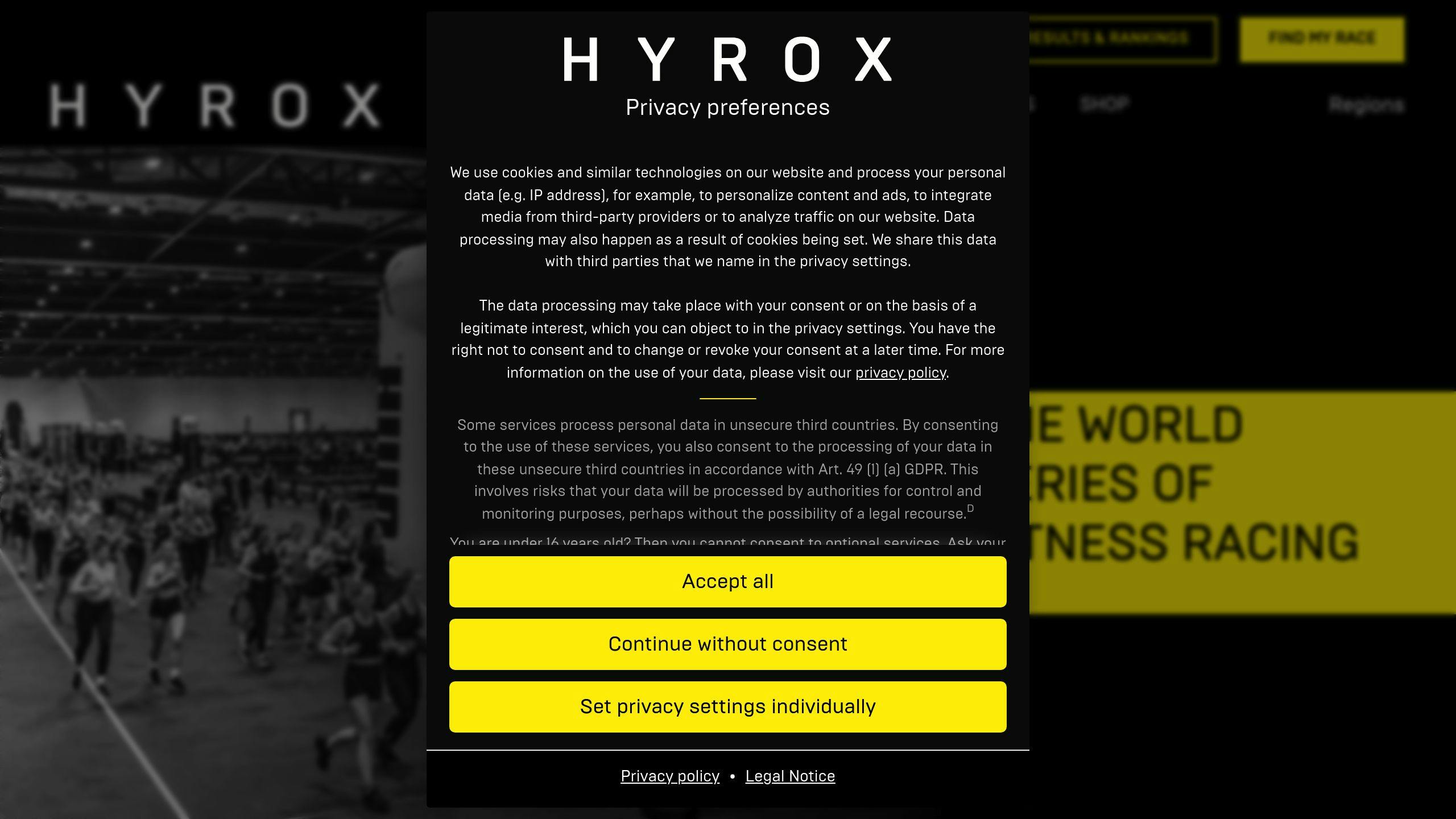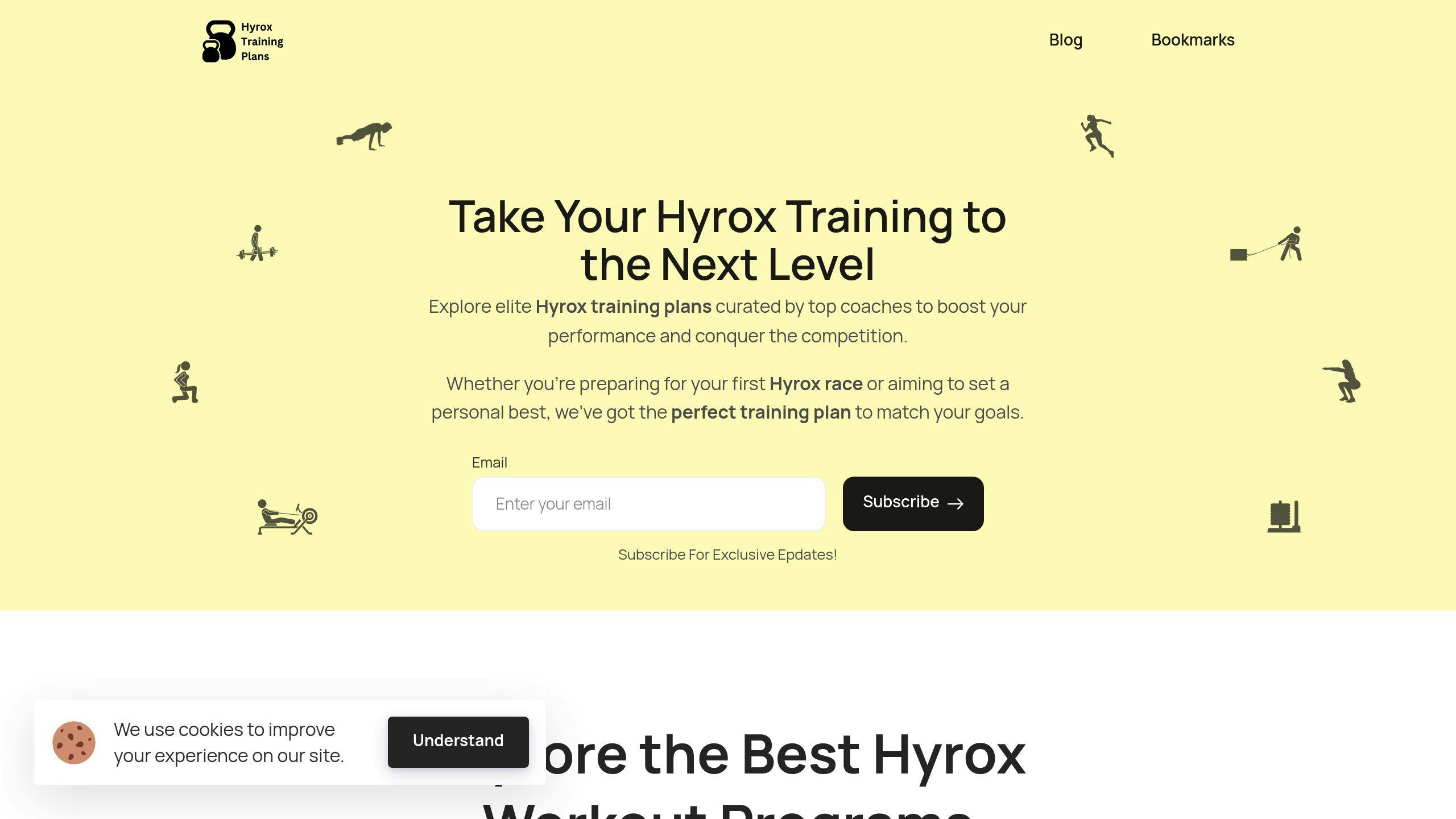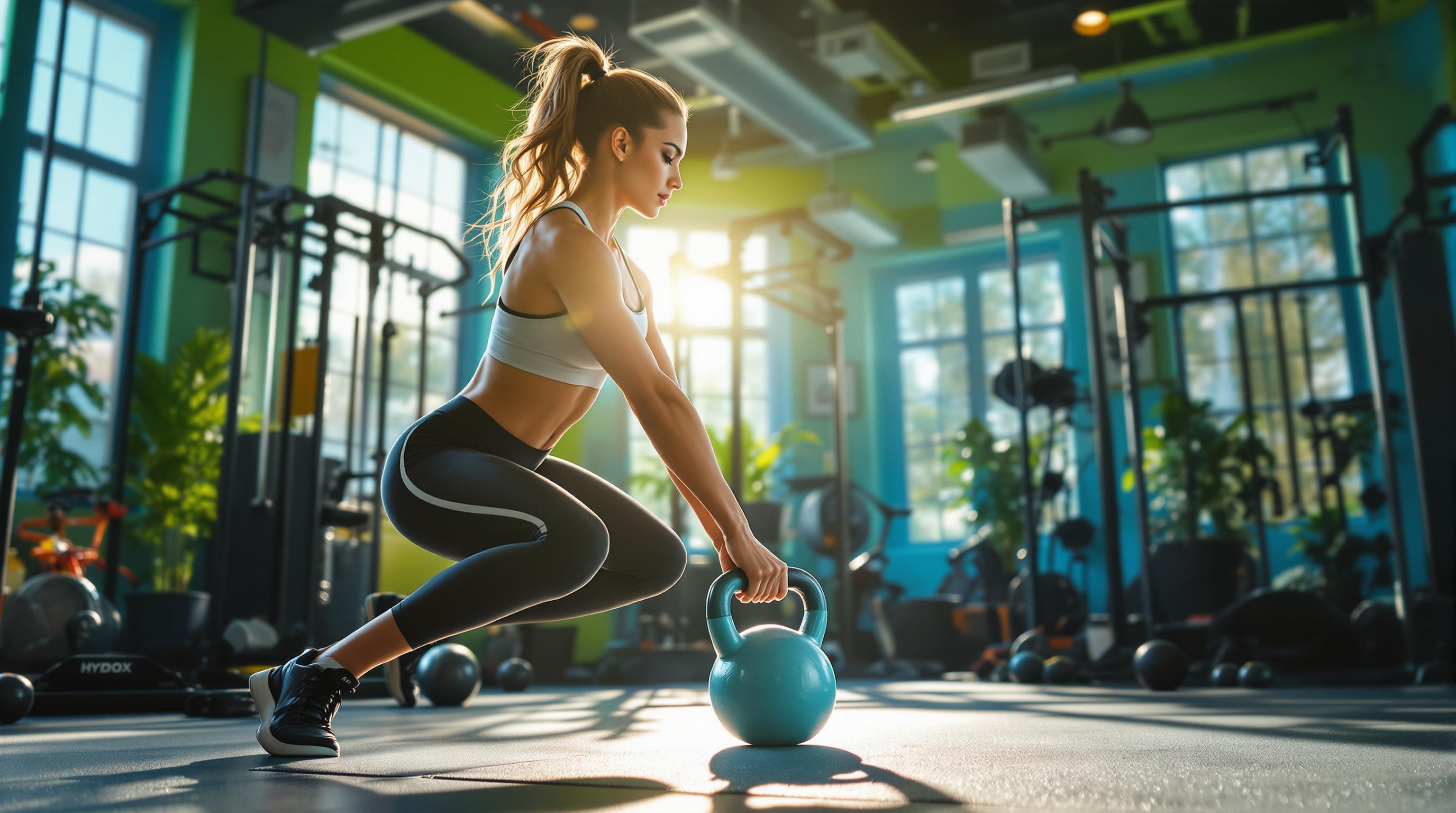Electrolyte balance can make or break your Hyrox performance. Why? Because Hyrox combines intense cardio and strength exercises, leading to significant sweat and mineral loss. Without proper electrolyte management, you risk cramps, fatigue, and poor recovery.
Key Takeaways:
- Electrolytes like sodium, potassium, magnesium, and calcium are critical for hydration, muscle function, and endurance.
- Hyrox athletes lose 2-6% of body weight in fluids during events, requiring tailored hydration strategies.
- Signs of imbalance include cramps, fatigue, and dizziness during or after workouts.
- Personalized strategies based on sweat testing can improve performance by up to 15%.
Quick Tips:
- Pre-Event: Hydrate with sodium-rich fluids 24-48 hours before.
- During Event: Consume 500-700ml of electrolyte solution per hour.
- Post-Event: Replenish sodium (500-1000mg/L) and potassium (200-300mg/L) in fluids.
Electrolyte management isn’t one-size-fits-all - test and adjust during training to optimize your plan for race day. Keep reading for a detailed guide on how to do this effectively.
Electrolytes and Their Role in Performance
What Are Electrolytes?
Electrolytes are minerals in your blood that carry an electrical charge, helping your body function properly - especially during demanding events like Hyrox. Here’s how key electrolytes support Hyrox athletes:
| Electrolyte | Function | Impact on Hyrox |
|---|---|---|
| Sodium | Regulates fluid balance and nerve signals | Helps prevent dehydration during wall balls and running |
| Potassium | Supports muscle contractions and heart rhythm | Maintains strength for sled pushes and pulls |
| Magnesium | Aids energy production and muscle relaxation | Enhances endurance for rowing and ski erg |
| Calcium | Drives muscle contraction and nerve communication | Powers explosive movements in burpees and lunges |
These minerals are essential for meeting Hyrox's unique physical demands.
Electrolyte Balance and Hyrox Performance

Hyrox events, lasting 60-90 minutes, challenge athletes with intense, multi-station formats. During this time, participants may lose 2-6% of their body weight in fluids, which can significantly deplete electrolytes. Here's how this impacts performance across specific stations:
- Running Segments: Low sodium can cause cramps and reduce stamina.
- Farmer's Carries: Insufficient potassium may lead to early muscle fatigue.
- Sled Work: Lack of magnesium can lower power output and increase exhaustion.
- Wall Balls: Calcium imbalances may disrupt coordination and muscle control.
A 2022 Connecticut study found that athletes who maintained their electrolyte levels sustained 15% more power output compared to those who only consumed water. This is critical for Hyrox, where consistent power and endurance are key.
In Hyrox settings, electrolyte imbalances can lead to:
- Reduced coordination during wall balls
- Power drops in sled exercises
- Early fatigue in running segments
- Poor pacing and decision-making
Staying on top of electrolyte levels can make a noticeable difference in performance.
Assessing Your Electrolyte Needs
Factors That Influence Electrolyte Requirements
Key considerations for Hyrox athletes:
Research by Baker et al. (2016) found that sodium levels in sweat can vary widely among athletes, ranging from 20-80 mmol/L. This highlights the importance of tailoring electrolyte strategies to individual needs.
| Factor | Impact | Consideration |
|---|---|---|
| Sweat Rate | Higher rates mean more electrolyte loss | Test during various training intensities |
| Training Volume | Longer sessions lead to greater depletion | Adjust intake based on workout duration |
| Body Size | Larger athletes generally need more | Base intake on body weight |
| Climate | Heat and humidity increase losses | Add 200-400ml/hour in hot conditions |
Recognizing Electrolyte Imbalance
A study by Smith et al. (2023) involving 150 Hyrox competitors revealed that 68% experienced muscle cramps during races, with 42% linking these to electrolyte imbalances. Spotting these signs early can help maintain performance.
Common warning signs:
- During activity: Muscle cramps (e.g., during wall balls or sled pushes), unexpected fatigue during running, dizziness between stations.
- Post-activity: Persistent thirst despite drinking water, dark urine or reduced output, slower recovery between sessions.
Testing and Monitoring Electrolytes
Dr. Jane Thompson advises serious Hyrox athletes to undergo professional sweat testing at least once per season to fine-tune their hydration and electrolyte plans.
Here’s a simple way to estimate your sweat rate:
1. Basic Sweat Rate Test
Determine your hourly sweat loss using this formula:
(Pre-workout weight - Post-workout weight) + fluid consumed = hourly loss
Example for a Hyrox session:
- Pre-workout weight: 75kg
- Fluid consumed: 500ml
- Post-workout weight: 74kg
- Calculation: (75kg - 74kg + 0.5kg) = 1.5L sweat loss per hour
2. Professional Testing
For Hyrox athletes, testing should focus on:
- Sweat analysis during high-intensity stations
- Monitoring electrolyte levels during recovery phases
- Hydration plans tailored to performance needs
"Understanding your individual sweat rate and electrolyte loss is crucial for optimizing performance in high-intensity events like Hyrox. What works for one athlete may not work for another." - Dr. Lindsay Thornton
These insights provide actionable guidance for Hyrox athletes to refine their electrolyte strategies during training and competition.
Strategies for Balancing Electrolytes in Hyrox Training
Preparing Electrolytes Before Training
Start preparing your electrolyte levels 24-48 hours before training. Aim to drink 5-7 ml of fluid per kilogram of body weight every 2-3 hours. About 2-3 hours before your session, consume 300-500 mg of sodium mixed into 500 ml of fluid. Finish this intake 45-60 minutes before training to give your body enough time to absorb the nutrients. These steps help you stay ready for the intense transitions unique to Hyrox competitions.
Managing Electrolytes During Training or Competition
Hyrox’s fast-paced station changes require careful on-the-go electrolyte management. Here’s a useful guideline:
"Proper electrolyte balance is not just about drinking water; it's about maintaining the right mineral concentrations to support muscle function and prevent fatigue during Hyrox's multi-station demands." - Dr. Stacy Sims, Exercise Physiologist and Nutrition Scientist
| Timing During Hyrox | Fluid Amount | Sodium Intake |
|---|---|---|
| Every 15-20 minutes | 125-250 ml | 300-600 mg/hour |
| Between stations | Sports drink (4-8% carbs) | 400-800 mg/L sodium |
Post-Hyrox Recovery
The recovery phase is just as important as the training itself. Focus on replenishing lost fluids and nutrients within the first few hours after your session.
- Immediate Recovery Window: In the first 2-4 hours after intense activities like sled pushes or farmer's carries, drink 1.5 times the fluid you lost during the workout.
- Recovery Drink Composition: Include 500-1000 mg of sodium and 200-300 mg of potassium per liter of fluid.
- Post-Hyrox Nutrition: Within 1-2 hours post-training, eat a meal rich in carbohydrates, proteins, and foods that naturally contain electrolytes to aid recovery.
sbb-itb-8bcd5e0
Sources of Electrolytes for Hyrox Athletes
Foods High in Electrolytes
Whole foods are a great starting point for meeting electrolyte needs during Hyrox training. For potassium and magnesium, dark leafy greens like spinach pack a punch, with 839 mg of potassium and 157 mg of magnesium per cooked cup. Bananas, a handy pre-workout choice, deliver 422 mg of potassium per medium-sized fruit. Post-workout recovery? Try half an avocado, which provides 345 mg of potassium.
For calcium and sodium, dairy products like Greek yogurt are excellent. A serving offers 70 mg of sodium along with a good dose of calcium. Almonds are another option - just an ounce provides 80 mg of magnesium.
While these foods provide a solid base, the high-intensity nature of Hyrox sessions often requires more targeted hydration strategies.
Electrolyte Drinks
Hydration is critical during Hyrox training, and different drinks can help meet specific needs:
| Drink Type | Key Benefits | Limitations |
|---|---|---|
| Sports Drinks | Great for mid-race energy | Often high in sugar |
| Coconut Water | Natural potassium source | Doesn't provide much sodium |
| Electrolyte Water | Light and refreshing | May lack sufficient electrolytes for intense workouts |
Electrolyte Supplements
For precise electrolyte management during Hyrox's demanding events, supplements can be a game-changer. Whether it's powders, tablets, or capsules, each option has its own strengths:
- Powders: These are versatile, allowing for custom dosing and quick absorption. Mix them into water for hydration during training or competition.
- Tablets: Compact and easy to carry, tablets are great for pre-workout prep. However, they can have a chalky texture.
- Capsules: Ideal for maintaining electrolyte levels between stations, though they absorb more slowly than powders.
In hot competition environments, sodium requirements can climb to 700-1000 mg per hour. Opt for supplements that allow you to adjust your intake based on the venue's conditions and your specific needs.
Creating an Electrolyte Plan for Hyrox
Adjusting Electrolyte Intake for Training Intensity
Your electrolyte needs vary significantly depending on how hard and how long you're training. For moderate Hyrox sessions lasting 1-2 hours, aim for 500-750mg of sodium per hour. For intense sessions or those over 2 hours, increase to 750-1000mg of sodium per hour, adding 150-200mg of potassium to aid muscle function.
| Training Intensity | Duration | Sodium Intake | Potassium Intake |
|---|---|---|---|
| Low (Recovery) | <60 min | Water sufficient | Minimal |
| Moderate | 1-2 hours | 500-750mg/hr | 100-150mg/hr |
| High (Race Simulation) | 2+ hours | 750-1000mg/hr | 150-200mg/hr |
These ranges align with sweat rate data gathered from earlier testing.
Fine-Tuning Your Race Day Electrolyte Strategy
For competition, plan to consume electrolytes every 15 minutes to keep levels steady. A 2022 sports science study revealed that personalized electrolyte strategies improved race performance by 6.5% compared to generic approaches.
"Electrolyte balance is not one-size-fits-all. Athletes need to experiment during training to find the right balance for their body and the demands of Hyrox competition."
Hyrox Training Plans and Electrolyte Management

Incorporating electrolyte management into your training is key. These plans combine sweat testing results with workout programming to help you refine your strategy for race day.
Here’s how they work:
- Tailored hydration protocols for different workouts
- Regular adjustments based on sweat testing
- Race simulations to put your plan to the test
These steps build on the sweat testing and tracking methods discussed earlier, ensuring you're prepared for the unique demands of Hyrox.
How to fuel for HYROX to perform your best
Key Takeaways on Electrolyte Balance for Hyrox Training
Electrolyte balance plays a crucial role in Hyrox performance, influencing muscle function and endurance. To optimize results, athletes should use sweat rate data from prior testing to create personalized hydration strategies. Here’s a breakdown:
- Pre-event: Hydrate with sodium-rich fluids about 24 hours before the competition.
- During the event: Consume 500-700ml of an electrolyte solution per hour at stations.
- Post-event: Focus on replenishing sodium (500-1000mg/L) and potassium (200-300mg/L).
Integrating these steps with sweat rate data and station-specific needs can help prevent performance dips, like power loss during sled work or coordination issues during wall balls. Regularly testing and adjusting your electrolyte plan during training simulations will fine-tune your race-day approach.



